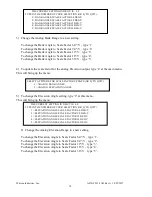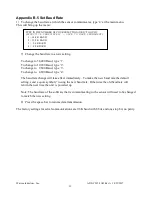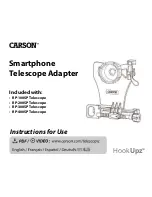
Watson Industries, Inc.
ADS-C232-3AD Rev A 10/25/2017
5
or plane of the structure. The magnitude of this secondary vibration is proportional to the angular
rate of turn.
Operation
Initialization
Ideally, the ADS should be stationary when it is turned on. If not, the sensor readings may not be
accurate after initialization. The time required for the initialization process is not the same for
every type of ADS, but typically takes 4 to 5 seconds. During this time, a message is sent from the
unit via the RS-232 serial link. This message gives information about the ADS such as the full
model number, serial number, and software revision. The message can be read by using a terminal
program or by using the terminal mode of Watson Industries’ communication software.
The ADS can also be “re-initialized” after it has been turned on. This is especially useful if the
sensor has been used in severe maneuvers that have over ranged the angular rate sensors and
caused significant errors to accumulate. Sometimes re-initializing the unit will allow for a faster
recovery than waiting for the error correction routines to correct the sensor readings. There are
several ways to re-initialize the ADS. For more information, see the Interface section of this
manual.
Normal Operation
In normal operation, the ADS takes data from its internal rate sensors and integrates them in a
closed loop system, with the accelerometers as a long-term reference, to generate the Bank, and
Elevation data. In most cases, these algorithms provide for very stable and accurate output signals;
however, the user should be aware that exceeding the normal ranges of the sensors would affect
accuracy. For example, while custom ADS units may have differing ranges, the rate gyros in a
typical ADS have a maximum rate of 100°/s. Care should be taken not to exceed this rate because
the closed loop system will receive inaccurate rate data. This will result in errors in the angle output
signals.
Special Operation Modes
Reference Mode
This mode is usually used for calibration or diagnostics. When in reference mode, the ADS will
output data generated directly from the sensor reference signals rather than as a product of the
closed loop integration used for normal operation. The reference command provides the same
sensor information as in normal operation mode with the following differences:
Bank and Elevation are obtained directly from the accelerometers - no gyro stabilization.
Angular Rate Sensors are not close-loop bias corrected, and the X and Y angular rate data
channels output X and Y Rate Bias values
The reference mode can be selected through the terminal mode. Note that reference mode is never
a default setting. It must be re-selected when re-powering the unit.
Free Mode
While in Free Mode, the ADS will output data from the sensors without correction by the
references. For example, the Bank Angle data output in Free Mode is calculated directly from the
X-axis Rate Sensor. In this case, the angle is a direct integration of the roll rate. Free Mode can be
used to totally reject effects from dynamic accelerations, but accuracy degrades with time. It is






































